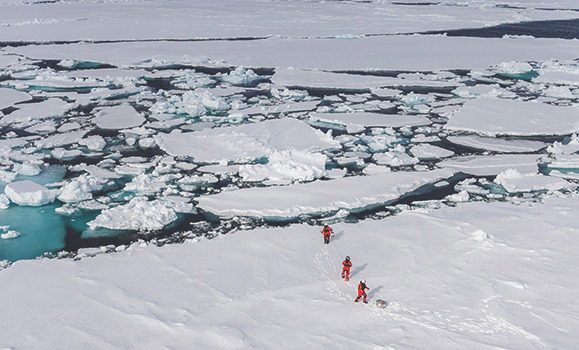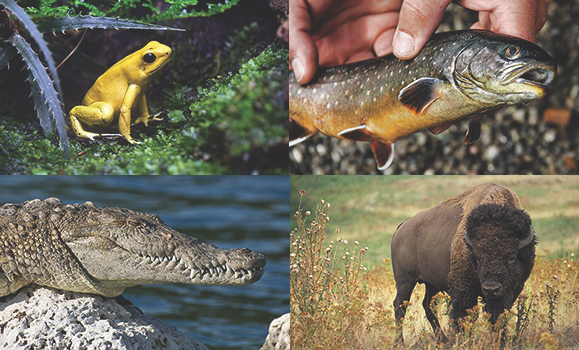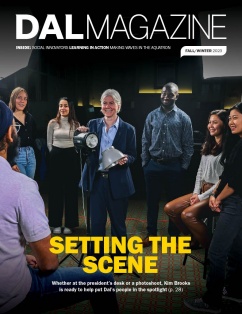Saving those swept into the seaÌý
Discovery & Innovation
Ìý
Peggy’s Cove is one of Canada's most iconic sites, with its distinctive lighthouse and rugged coastline drawing roughly 800,000 visitors every year. It is also a place that carries certain risks due to high waves that have swept people off the rocks and into the sea. The often tragic outcome prompted Dalhousie Engineering students to develop a device that can keep people afloat until they can be rescued.
The team designed and built a tubular launching device that will shoot an inflatable life-jacket to the victim within the critical 60 seconds after they fall in. It can travel 100 feet through high-force winds and features CO2 cannisters that can inflate a life-jacket, which is tethered to the launcher by a plastic safety rope, allowing bystanders on- shore to pull the victim to safety.
Researchers: Willem Glozanski, Zach Gould, Liam Carson, Paul D'Eon and Tanner Duplessis.
Read more:ÌýStudents make device to save people in peril from powerful waves at Peggy's Cove (Dal News)
Distant marine food source clogged with microplasticsÌý
Environment, Climate Action, Life on Land, Sustainable Ocean
Ìý
It is a food elevator for bottom-dwelling animals in the deep sea: the algae melosira arctica grows rapidly under Arctic sea ice, forming metre-long cell chains that become an important food source for marine life and bacteria.
In addition to food, however, Dalhousie researchers have determined these aggregates also transport a dubious cargo into the deep sea: microplastics.
The team collected samples of the algae and surrounding water from ice floes off Greenland in 2021 and found the algae contained about 10 times the amount of plastics compared to the sea water. It enters the food chain when the zooplankton is eaten by fish, such as polar cod which are eaten by seabirds and seals and in turn by polar bears.
The detailed analysis found a variety of different plastics, in- cluding polyethylene, polyester, polypropylene, nylon, acrylic and many more.
Researchers: Steve Allen, Ocean Frontier Institute; Alfred Wegener Institute; University of Birmingham
Read more:ÌýMicroplastics found in naturally occurring slime under Arctic ice capÌý(Dal News)

Microplastics fall to the ice or are carried there by seawater and become embedded in the slime below the ice before drifting into marine food webs (supplied).
Winter offers no defence against Lyme-infected ticksÌý
Environment, Climate Action, Life on Land
Ìý
Winter used to offer a reprieve from the irritation and potential health risks associated with certain species of ticks—the leggy arachnids that are tough to kill and can carry a host of diseases. Sub-zero temperatures were thought to reduce their survival rates, but new research shows that female deer ticks infected with the pathogen that causes Lyme disease are more likely to survive winter than uninfected female ticks.
Researchers collected ticks on Nova Scotia's south shore and monitored their overwintering abilities in forests and dune grasses from 2018 to 2021. They found that infected ticks had greater survival rates compared to uninfected ticks for three consec- utive winters, raising questions as to whether the presence of the pathogen makes them able to tolerate the cold.
Researchers: Shelley Adamo, Amal El Nabbout; Teikyo University; Acadia University
Read more:ÌýBalsam fir needles could help kill blacklegged ticks and reduce the spread of Lyme disease, study showsÌý(Dal News)
World's most voracious predators? It's usÌý
Life on Earth
Ìý
It's long been known that humans exact a heavy toll on the environment, but quantifying that impact compared to other species has proved a little tricki- er...until now.
An international team of researchers analyzed human ‘use’ data for 45,000 vertebrate species, finding that more than one-third of all vertebrate spe- cies on Earth are now being used by humans who were found to take up to 300 times more prey species than their competitors, causing outsized impacts on natural ecosystems.
As a result, almost 40 per cent of those exploited vertebrate species are now threatened by humans. Humans also use prey species differently. While other top predators kill almost exclusively for food, human's practice of capturing terrestrial animals for the pet trade outnumbered food uses almost two to one.
Researchers: Boris Worm; University of Victoria; Raincoast Conservation Foundation; UK Centre for Ecology & Hydrology; University ofÌý British Columbia; University of Northern British Columbia; University of California; São Paulo State University; Florida International University; Oregon State University; University of Victoria; Hakai Institute.
Read more:ÌýHumans exact 'supersized' toll on world's ecosystems, international study finds (Dal News)

Nearly 40 per cent of exploited bertbrate species are threatened by humans.
Combatting stress linked to cancerÌý
Healthy People, Healthy Communities, Healthy Populations
Ìý
Getting a diagnosis of prostate cancer can be devastating, carrying with it profound psychological stress, feelings of isolation and anxiety.
To address that, a team of scientists and physicians at Dalhousie developed the Prostate Cancer Patient Empowerment Program (PC-PEP) and found in a study that it significantly lowered rates of depression and other forms of psychological distress compared to those receiving standard care.
The program provides online physical, mental and social support over a six-month period to men being treated for prostate cancer. It consists of daily e-mails with video instructions on patient activities and healthy living guidance, including dietary recommendations, physical fitness, stress reduction and social connection recommen-dations.
At six months, patients in the control group had almost four times higher odds for psychological distress and need for psychological treatment than men who received the PC-PEP intervention.
Researchers: Gabriela Ilie, Rob Rutledge, Ricardo Rendon, Ross Mason, Cody MacDonald, Michael J. Kucharczyk, Nikhilesh Patil, David Bowes, Greg Bailly, David Bell, Joseph Lawen, Michael Ha, Derek Wilke, Peter Massaro, Jeffery Zahavich, George Kephart.
This story appeared in theÌýDAL Magazine Fall/Winter 2023Ìýissue. Flip through the rest of the issue using the links below.


